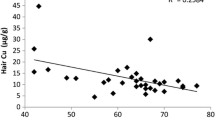Abstract
The statistical tests analysis of variance, analysis of covariance, correlation coefficient, Kolmogorov-Smirnov test,t-test, and Tukey test were applied to copper, magnesium, managenese, and zinc content in serum (S) and in cerebrospinal fluid (CSF) of controls and of a sporadic form of Amyotrophic Lateral Sclerosis (ALS) disease. This is carried out in order to evaluate statistically the possible relationships among the trace elements when ALS patients and controls are considered as independent groups, within sex groups and within age decades of both patients and control classes. A statistically significant difference between older controls (age >40) and ALS patients (age>40) for copper in CSF, copper in S, manganese in S, and zinc in CSF was found. Statistically significant correlation coefficients within the different classes formed for this study were observed. Within this pool, a correlation of patient group can differ statistically from the corresponding one of controls and vice versa. Thus, this correlation could be characteristic of the group from which is extracted, e.g., the correlation between copper in S and zinc in S, which is characteristic of ALS patients when considered as an independent group as well as members of the male patient class.
Similar content being viewed by others
References
F. A. Aran, Researches sur une maladie non encore de' Crite de systeme musculaire (Atrophie musculaire progressive),Arch. Gen. Med. 24, 15–35, 172–214 (1850).
S. S. Khare, W. D. Ehmann, E. J. Kasarskis, and W. R. Markesbery, Trace element imbalances in amyotrophic lateral sclerosis.Neuro Toxicology 11, 521–532 (1990).
R. D. Currier and A. F. Haerer, Amyotrophic lateral sclerosis and metallic toxins,Arch. Environ. Health 17, 712–719 (1968).
Y. Yase, The pathogenesis of amyotrophic lateral sclerosis,Lancet 2, 292–296 (1972).
L. W. Chang, Neurotoxic effects of mercury—A Review,Environ. Res. 14, 329–373 (1977).
W. J. Manton and J. D. Cook, Lead content of CSF and other tissues in amyotrophic lateral sclerosis,Neurology 29, 611–612 (1979).
S. Conradi, L. O. Ronnevi, and O. Vesterberg, Abnormal distribution of lead in amyotrophic lateral sclerosis: Re-estimation of lead in CSF,J. Neurol. Sci. 48, 413–418 (1980).
F. Yoshimasu, M. Yasui, Y. Yase, S. Iawta, D. C. Gajdusek, C. J. Gibbs, and K. Chen, Studies on amyotrophic lateral sclerosis by NAA-2: Comparative study analytical results on Guam P.D., Japanese ALS and Alzheimer disease cases,Folio Psychiatrica et Neurologica Japonica 34, 75–82 (1980).
R. Yanagihara, inHuman Motor Neuron Disease, L. P. Rowland, ed., Raven, New York, 233–247 (1982).
H. Nagata, S. Miyata, S. Nakamura, M. Kameyama, and Y. Katsui, Heavy metal concentrations in blood cells in patients with ALS,J. Neurol. Sci. 67, 173–178 (1985).
W. Maenhaut and J. Cafmeyer, Particle induced x-ray emission analysis and multivariate techniques: An application to the study of the sources of respirable atmospheric particles in Gent-Belgium,J. Trace Microprobe Techn. 5, 135–158 (1987).
O. M. Kvalheim, K. Oygard, and O. Grahl-Nielsen, Simca multivariate data analysis of blue mussel components in environmental pollution studies,Anal. Chim. Acta 150, 145–152 (1983)
V. Kilikoglou and A. P. Grimanis, Chemical characterization of bronze age pottery from Greek south Aegean islands by instrumental neutron activation analysis,J. Radioanal. Nucl. Chem. 168, 297–306 (1993).
E. Marengo, C. Baiocchi, M. C. Gennaro, D. L. Bertolo, S. Lanteri, and W. Garrone, Classification of essential mint oils of different geographic origin by applying pattern recognition methods to gas chromatographic data,Chemometr. Intelligent Lab. Syst. 11, 75–88 (1991).
H. Duflou, W. Maenhaut, and J. De Reuck, Application of principal component and cluster analysis to the study of the distribution of minor and trace elements in normal human brain,Chemometr. Intelligent Lab. Syst. 9, 273–286 (1990)
G. D. Kanias and E. Kouri, Biological evaluation of trace element data in human ovaries by statistical analysis.J. Biol. Trace Elem. Res. 52, 65–116 (1996)
E. Kapaki, I. Segditsa, and C. Papageorgiou, Zinc, copper and magnesium in serum and cerebrospinal fluid in patients with neurological disorders,Acta Neurol. Scand. 79, 373–378 (1989).
E. Kapaki, Lecturer Thesis, Medical Scool, Athens University (1989).
E. Kapaki, personal communication (1995).
B. Halliwell, Reactive oxygen species and the central nervous system,J. Neurochem. 59, 1609–1623 (1992)
Author information
Authors and Affiliations
Rights and permissions
About this article
Cite this article
Kanias, G.D., Kapaki, E. Trace elements, age, and sex in amyotrophic lateral sclerosis disease. Biol Trace Elem Res 56, 187–201 (1997). https://doi.org/10.1007/BF02785392
Received:
Revised:
Accepted:
Issue Date:
DOI: https://doi.org/10.1007/BF02785392




